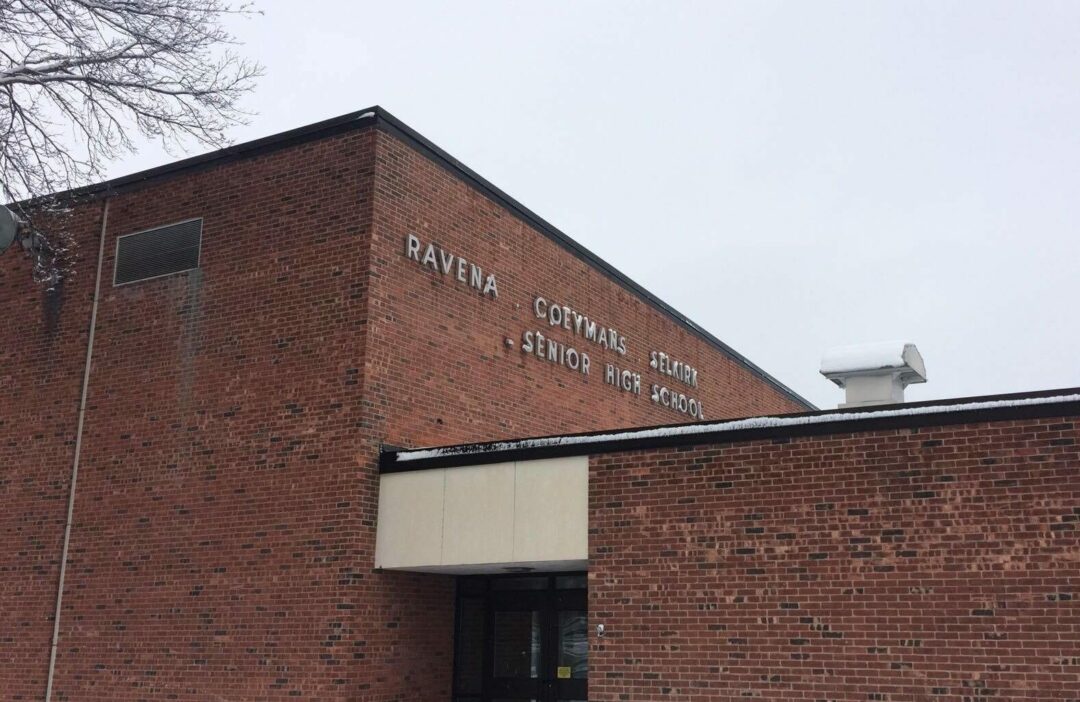COEYMANS—The new gymnasium at Ravena-Coeymans-Selkirk High School is expected to be completed by the end of April, according to CSArch and Turner Construction, the architect and construction firms hired for the project.
In January 2015, district voters approved a $30.09 million capital project, a two-part plan that included construction of the new high school gymnasium, tennis courts, soccer fields and a new multi-purpose building, as well as reconstruction or renovation to various district buildings and facilities deemed necessary for health, safety, accessibility and code compliance.
 According to Rob Stewart, the project manager for Turner Construction, the project has remained largely on schedule, despite frigid winter temperatures and state Education Department approval delays. In May, the conversion of the existing gymnasium into a multi-purpose building with a choral suite will begin while other interior renovation work will continue over the summer while students are not in the buildings.
According to Rob Stewart, the project manager for Turner Construction, the project has remained largely on schedule, despite frigid winter temperatures and state Education Department approval delays. In May, the conversion of the existing gymnasium into a multi-purpose building with a choral suite will begin while other interior renovation work will continue over the summer while students are not in the buildings.
“Significant renovations here at the high school,” Stewart said during a February 6 Board of Education meeting, “as well as the parking lot out behind the gymnasium, and the new canopy at the front entrance.”
“There will be an awning that starts at the main entrance and comes almost all the way out to the roadway with a big RCS out in front,” RCSCSD Superintendent Brian Bailey later explained. “So people will have a clear understanding of where the entrance to the school is. And that will extend to renovations of the high school lobby, the high school main office and about half of the existing gymnasium is going to be repurposed—they’re going to build a music performance suite and an additional classroom in that space.” The other half, he said, will serve as a single-court practice gym.
“Our music program outgrew their space many years ago,” said Bailey. “So to be able to come up with a new rehearsal space for them will be great.”
The new softball/soccer fields, which School Board President James Latter noted have been strewn with equipment, will not be fully finished this summer as originally anticipated due to difficulty with the soil on the property, according to Stewart. While they will be usable, he said, they will not be sodded until just prior to use in the fall. (Bailey assured Latter that alternate fields have been secured for spring softball teams.)
The majority of phase II, which began last summer, is expected to be ready for

functional use by the time classes begin in the fall. (Renovation of the kitchen/cafeteria/receiving area at the middle school will not be completed until next fall.) While ancillary systems, aesthetic touches and minor repair work may not be entirely complete, according to the district, required life safety systems will be in place and spaces will be ready for occupancy.
While phase III remains under review by SED, said Edwin Anker, a primary architect at CSArch, he expects to receive approval any day. If that happens as expected, the work will be bid out in the spring and should be completed by the fall of 2019. Phase III will not only involve renovations to the middle school’s Family & Consumer Science and Art classrooms, but also include renovations and miscellaneous infrastructure upgrades at both elementary schools.
Phase I of the project saw improvements to A.W. Becker and Pieter B. Coeymans elementary schools, including: upgrades to the library; window replacement; HVAC upgrades; new boilers; electrical service replacement; and athletic upgrades. In addition to a variety of other improvements, the high school/middle school campus received a new synthetic field and auditorium upgrades, while the district’s bus garage got a new roof, overhead doors, propane filling station and access road.
One of the most obvious changes, said Bailey, has been the relocation of the  tennis courts from the back of the high school to the field between the middle school and Route 9W. The district has plans to install wind blocks with the RCS logo facing 9W, which it will also install on the fencing surrounding the stadium at the north end of the campus. “We’re hoping to make it more attractive,” he said. “The problem with brick block buildings is that they don’t have a lot of curb appeal, necessarily.”
tennis courts from the back of the high school to the field between the middle school and Route 9W. The district has plans to install wind blocks with the RCS logo facing 9W, which it will also install on the fencing surrounding the stadium at the north end of the campus. “We’re hoping to make it more attractive,” he said. “The problem with brick block buildings is that they don’t have a lot of curb appeal, necessarily.”
Other improvements are less obvious but still needed, such as the boilers at the elementary schools. “Nobody can see that,” said Bailey, “but that is a huge infrastructure renovation.” He explained that school districts generally pay for expensive maintenance and needed capital improvements by planning large capital projects that are put before voters and taking on debt that is then paid off over a period of time as part of the district’s budget. When that debt is nearly paid off, another capital plan is devised, which should address district needs, enrollment and finances.
Capital projects tend to occur in RCSCSD approximately 15 years apart, which corresponds with the approximate lifetime of the debt taken on to complete those projects. “What happens is,” said Bailey, “if everyone has their heads on straight, two or three years prior to the debt rolling off, they start having conversations about how the district will maintain a level budget.”



